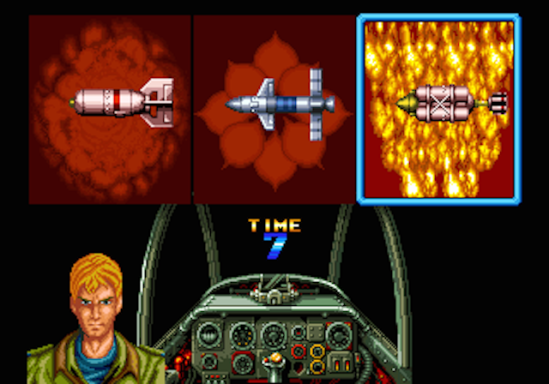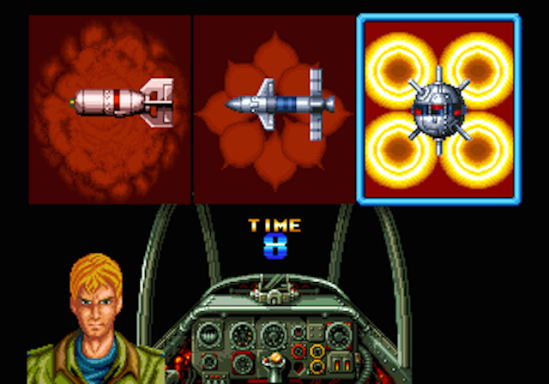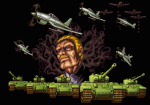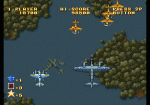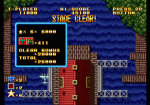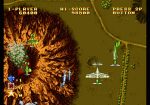In this long-delayed edition of 100 Days of MEGASHOCK!, we’ll be looking at Alpha Mission 2 (known as ASO II: Last Guardian in Japan). Similar to Baseball Stars, Alpha Mission 2 is a Neo Geo sequel to an SNK title made prior to the Neo Geo’s debut. The original Alpha Mission was developed for arcades in 1985 and then ported to the famicom/NES. But unlike Baseball Stars, the Alpha Mission series never progressed past this second entry. Incidentally, skimming the Neo Geo release list shows that all subsequent SNK-developed games will be original Neo Geo stuff (although there will be plenty of callbacks and references to SNK’s pre-Neo Geo library of games).
Alpha Mission 2 is a vertical scrolling shooter, similar to Ghost Pilots, which we looked at in post #14. But where Ghost Pilots took a more grounded fake-historical approach, with planes being inspired by real-world World War 1 and 2 era planes, Alpha Mission takes a more scifi approach, so lots of flying in space, shooting robot aliens, and having boss fights with huge spaceship on different planets.
In Alpha Mission 2, you have 2 types of shots: Lasers that destroy flying targets, and air-to-surface missiles that destroy ground targets. It’s works a lot like Xevious, and you can assign lasers and missiles to shoot simultaneously with just the ‘A’ button, or have them separately assigned to ‘A’ and ‘B’ respectively. Unlike most shooters, There are no bombs that decimate enemies and clear-up bullets from the screen. Instead, you can select one of several types of “Armors” with the ‘C’ button, wherein the ship will temporarily transform into a much stronger one equipped with more powerful weapons and a better armor that can take multiple hits. This is the signature feature of the Alpha Mission series.

It’s generally a good idea to activate armor at boss fights, like so. Note the energy bar at the left, which now depletes with each hit.
However, you don’t come upon these Armor upgrades so easily. Alpha Mission 2 requires you to collect each armor piece by piece, and there are 11 armor types, such as HOME (as in homing), FIRE, SIDE, BUBBLE etc. In order to build-up one armor type you are required to collect 3 pieces of the same armor type CONSECUTIVELY. Collecting any other armor type would reset it, so then you have to start over again. However, you can simply buy complete armor sets at the end of each level, granted that you have enough ‘G’ currency for it.

This boss reminds me of the second boss of Ikaruga, which has a similar moving shaft thing that conceals a weakpoint while you keep getting shot at from the side.
And there are more items to collect in Alpha Mission 2. Collecting items like speed (with an ‘S’ item), or lasers (with ‘L’), or missile (with ‘M’) will upgrade that ship attribute. In addition, some levels have warp items that warp you a few screens ahead in a stage. Other items warp you BACK a few screens. Then there are items that power you down, either by depleting the Armor energy, or by decreasing your stock ship attributes.
And all these upgrades you gathered will disappear as soon as you die, which is one reason why I’m not totally into Alpha Mission 2. I think it’s somewhat of a rule in video games that if a game has so many upgrades, whether it’s a shooter or RPG or metroidvania or even career-mode in a racing game, then the initial stock attributes of the player ship/character/car are made so middling in order to allow some room to grow. Sometimes good game designers try to make that initial portion of the game feel great, or at least reduce that portion as much as possible so that you’re already getting a number of upgrades so early into the game. But Alpha Mission 2 does neither to alleviate that. I realize that Gradius and other shooters with upgrades mechanic do the same thing, but they’re more streamlined and focused. In Gradius for example, the energy-pellets can be accumulated to upgrade any stat of the ship, whether it’s speed or adding sideweapons or whatever. Fantasy Zone uses currency that you collect and then spend at shops floating around in any level. In TwinBee, shooting at clouds reveal these bells. And Shooting those bells makes them change color and thus which power-up you get. Alpha Mission 2 sorta takes all these upgrade-type ideas and smooshes them together without much rhyme or reason, without making them gel together. It’s like living in an economy that has 2 or more currencies for mutually exclusive goods and services. A more uniform upgrade method would have helped make Alpha Mission 2 a better game.
I mean it could be a symptom of me sucking at scrolling-shooters, but I think for the most part I’m playing the game trying to acquire power-up (or better yet, acquiring the RIGHT power-up items while actively trying to avoid others) more so than trying to play the level itself, because the stock-ship simply isn’t fun at all to play. It’s slow and weak. Fighting bosses with the stock-ship is an unfun chore that lasts way too long.
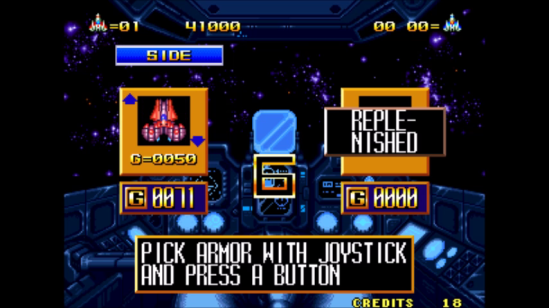
You can buy armor upgrades at the end of each level. I just can’t seem to get enough ‘Gs’ to get the good armor types.
Then there’s the issue with lasers and missiles. As I mentioned before, each of these weapons attack a certain type of target, and what gets killed by one usually doesn’t get damaged by the other. Lasers go faster and further, and they can be shot more frequently. So they’re the easier weapon to handle than the slower missiles, which require more deliberate placement. And that’s fine because for the most part, the more immediate threats come from flying targets as most of the grounded targets shoot slow projectiles that are easy to dodge, or they contain one of the various pick-ups to upgrade your ship.
But then you reach a boss. And many of the bosses can only be damaged by missiles (or at least have major parts/final forms that are only vulnerable to missiles) and it’s just an excruciating bore to fight, especially compounded with the resetting-upgrades issue. A big offender is the Boss of Area 5:-

…until it submerges part of itself. But then you say “look, parts of it are still in the open”. And you are correct. However…

It can submerge itself COMPLETELY. Becoming fully invulnerable. All I can do is wait till it emerges again. Ugh so infuriating.
That boss fight took around 5 minutes exclusively, which is pretty long for a shooter. I guess what I want to say is some of the boss fights in Alpha Mission 2 aren’t great.
Still, I feel like Alpha Mission 2’s problems aren’t necessarily the ideas it has. It’s just that they’re not balanced well. And for the most part, Alpha Mission 2 is a decent shooter with a ok graphics . It looks more like an enhanced 8-bit shooter than a true 16-bit shooter, with tiny ships and lots of tiny enemies and targets on screen. Only the bosses and some of the backgrounds in the game look large, with impressive animations. It more resembles the likes of Star Soldier or Zanac but if they got an enhanced 16-bit port. And considering that the first Alpha Mission was exactly that sort of mid-80s 8-bit shooter, it’s not surprising that its sequel maintains that look.
And Alpha Mission 2 still has its moments. I like how Stage 2 is all a fight against a massive multiscreen mothership, where you’re tasked to destroy different parts of it, and then to enter the ship itself during the second half of the stage to permanently destroy it from the inside. Stage 4 has some nice backgrounds. And I like the fight against the final huge-terminator-looking boss. Plus I think Armors are a pretty cool alternative to your regular shooter-bombs. And there’s plenty of Armor types that you’ll probably not be able to try them all in one or two playthroughs.
It’s ironic to compare Alpha Mission 2 to Ghost Pilots. Ghost Pilots issues were that it was a very uninspired vertical shooter with not a lot of neat new ideas or features. But in being so, it also didn’t have anything objectionable. Alpha Mission 2 on the other hand incorporates a few novel ideas (some taken from other games, like Xevious as I mentioned). It has all these upgrades and features and shops and warps. But it does not balance them well. Half the time, you’re focused on which pick-ups you wanna get & which you wanna avoid. And then you die and end up fighting a boss who takes about 5 minutes to die strictly because you only have your puny stock missiles that barely chip away damage. With some balancing Alpha Mission 2 could have been great. Sadly, the series never got the chance to better itself with a 3rd installment. But it’s ok, there’s plenty of better shooters on the Neo Geo, which we’ll soon be looking into (that is, if I can put these posts out more frequently, haha).














